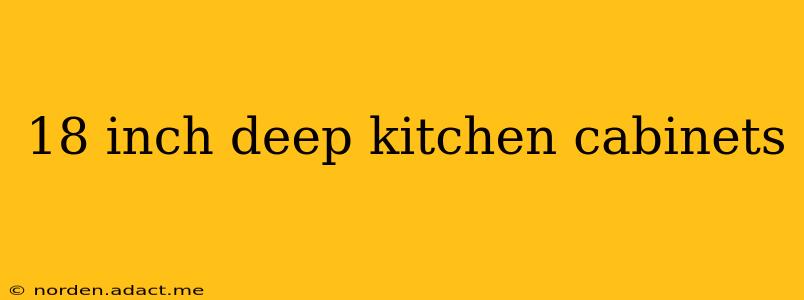Are you dreaming of a beautifully organized kitchen, but struggling with limited space? 18-inch deep kitchen cabinets might be the perfect solution. These shallower cabinets offer a surprising amount of storage while enhancing the overall aesthetic of your kitchen. This comprehensive guide explores the benefits, considerations, and frequently asked questions surrounding 18-inch deep kitchen cabinets.
Why Choose 18-Inch Deep Kitchen Cabinets?
Standard kitchen cabinets typically range from 21 to 24 inches deep. Opting for 18-inch deep cabinets offers several key advantages:
-
Space Optimization: In smaller kitchens or galley kitchens, these shallower cabinets can significantly increase usable floor space, making the kitchen feel more open and less cluttered.
-
Improved Workflow: With items stored closer to the front, accessing frequently used dishes, cookware, and utensils becomes easier and more efficient.
-
Enhanced Aesthetics: In some kitchen designs, shallower cabinets can create a sleeker, more modern look, especially when paired with appropriately sized countertops.
-
Cost-Effective Solution: While the initial cost might vary depending on materials and customization, 18-inch deep cabinets can often be more budget-friendly than standard-depth cabinets, as they require less material.
What are the Downsides of 18-Inch Deep Cabinets?
While offering numerous benefits, it’s important to weigh the potential drawbacks:
-
Limited Storage Capacity: Naturally, an 18-inch deep cabinet holds less than a 24-inch deep cabinet. This necessitates careful planning and organization to maximize storage.
-
Suitability for Specific Items: Larger items like bulky pots, pans, or appliances might not fit comfortably in shallower cabinets.
-
Planning and Design: Proper planning is crucial to ensure that the reduced depth doesn't compromise functionality or accessibility.
What Can I Store in 18-Inch Deep Cabinets?
This often-asked question hinges on effective organization. Here are some items ideally suited for 18-inch deep cabinets:
-
Dishes and Glasses: These typically fit comfortably in this depth.
-
Smaller Cookware: Saucepans, skillets, and smaller baking dishes generally work well.
-
Canned Goods: These stack efficiently, utilizing the available space effectively.
-
Utensils and Cutlery: Drawers and organizers can be incorporated to maximize storage.
-
Plates and Serving Dishes: Consider using dividers or trays to prevent stacking and keep items organized.
Are 18-Inch Deep Cabinets Right for My Kitchen?
The suitability of 18-inch deep cabinets depends largely on your kitchen's size, layout, and your storage needs. Consider these factors:
-
Kitchen Size: Small kitchens benefit most from increased floor space.
-
Storage Needs: Assess your current kitchenware and determine if it will all fit comfortably.
-
Layout: Think about the flow of your kitchen and how the shallower cabinets will impact your workflow.
How Much Storage Space Do I Lose with 18-Inch Deep Cabinets?
The exact amount of storage space lost depends on the cabinet's dimensions and the items you store. However, as a general rule, you can expect to lose approximately 6 inches of depth per cabinet. To compensate, consider maximizing vertical space with taller cabinets or adding pull-out shelves and organizers.
Can I Mix and Match Cabinet Depths?
Absolutely! Mixing and matching cabinet depths is a popular design choice. You could use 18-inch deep cabinets in areas where space is at a premium and standard-depth cabinets where more storage is needed. This allows for customization and better suits individual needs.
Where Can I Find 18-Inch Deep Cabinets?
Custom cabinet makers are your best bet for getting 18-inch deep cabinets tailored to your exact specifications. Some major home improvement stores may offer pre-fabricated options, although the selection might be more limited.
By carefully considering the pros and cons and planning your layout thoughtfully, you can effectively utilize 18-inch deep kitchen cabinets to create a beautiful, functional, and space-saving kitchen. Remember to consult with a kitchen designer or contractor to ensure your choices best suit your needs and preferences.
